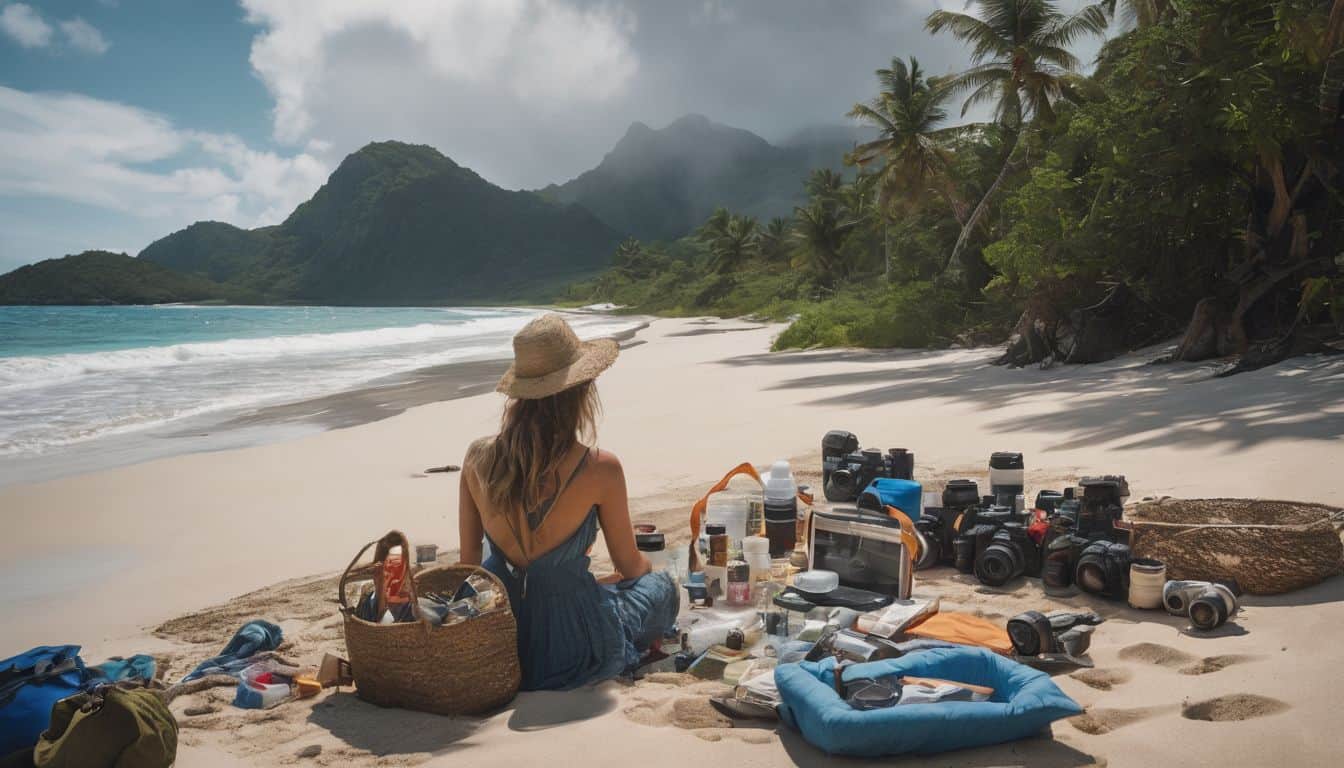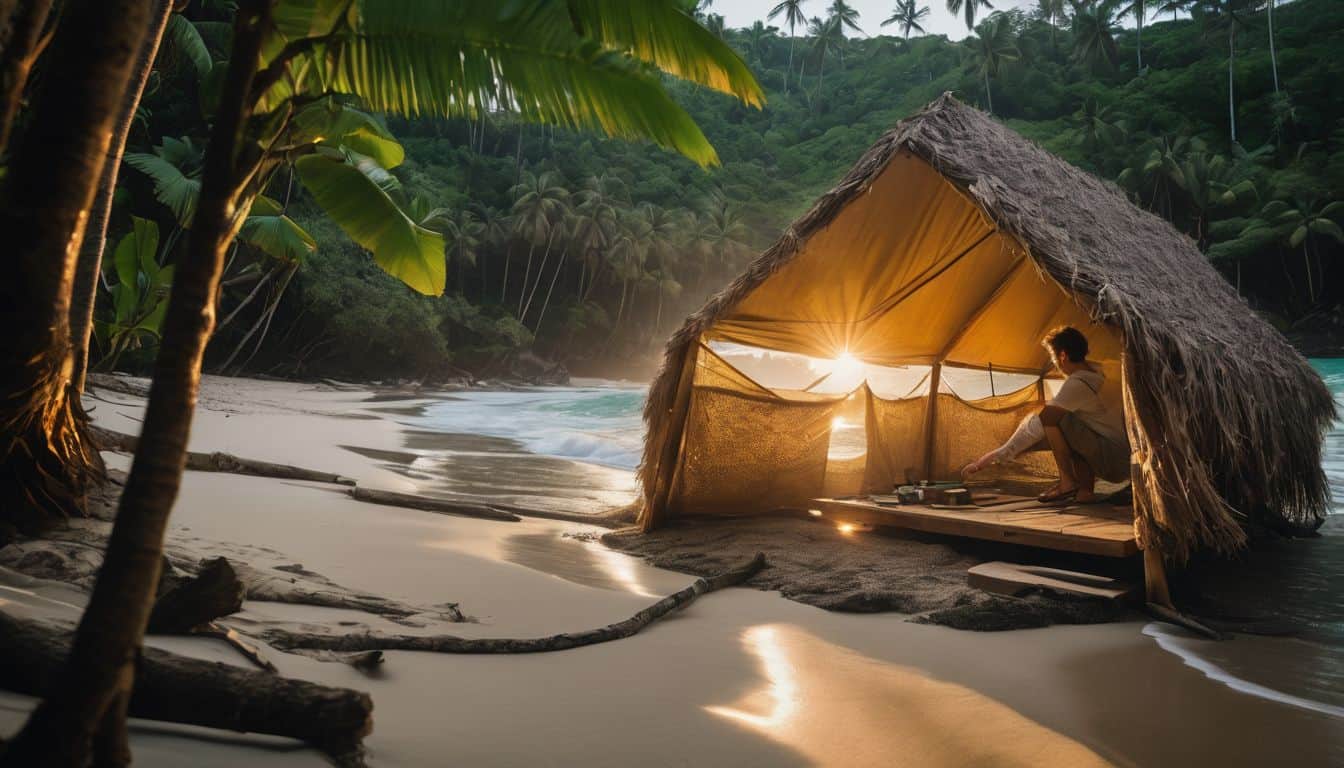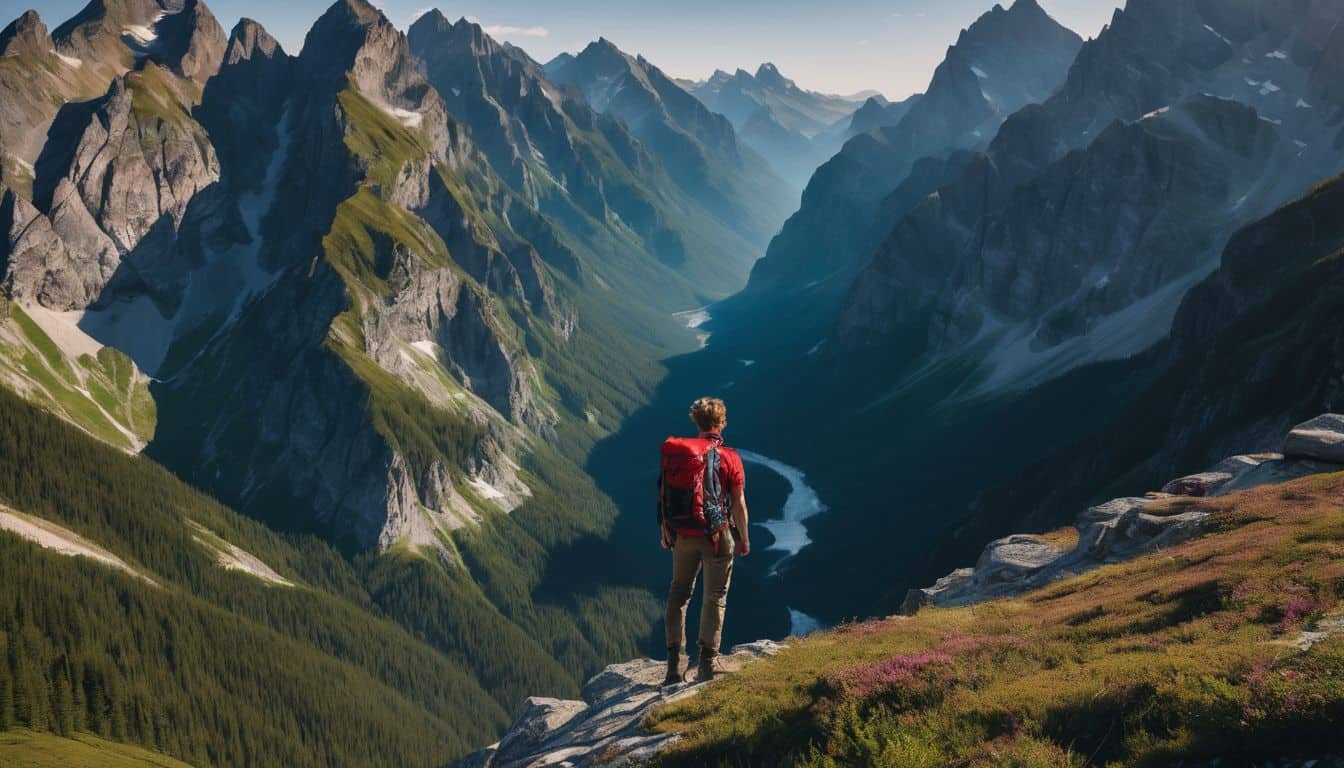We’ve all had those fleeting moments, lost in the thought of being marooned on a picturesque island, miles away from the hustle and bustle of civilization. But when reality bites, it’s far from this idyllic dream – trust me, I’ve spent more than enough time researching survival strategies to know better! It’s about grappling with an unforgiving wilderness while coming to terms with mounting solitude.
So let’s delve into this guidebook together; we’ll unravel nine crucial survival techniques necessary for thriving against such formidable odds. Brace yourself: Your transformative journey towards becoming a desert island champion begins here!
Key Takeaways
- Assess your available resources and prioritize their importance to survive on a deserted island.
- Maintain a positive mindset and mental preparedness to cope with isolation, loneliness, and uncertainty.
- Learn essential survival techniques such as the S.T.O.P method, building a shelter, finding and purifying water, starting a fire without matches, and identifying edible plants and catching food.
- Be aware that even small mistakes can have serious consequences in the wilderness.
Take Inventory of Your Supplies
Assess available resources to determine what supplies you have on the deserted island and prioritize their importance for your survival.
Importance of assessing available resources
Knowing what I have is key to survival. It’s not about how much stuff I have, it’s about knowing its worth. Looking at my supplies gives me a clear idea of what I can do with them.
It tells me how long they will last and helps plan for tough days ahead. This kind of check makes sure I don’t get caught off guard and keeps panic at bay. Analyzing my resources also lets me see gaps that need filling in before trouble hits hard.
Essential items to have on a deserted island
Being ready for all that Mother Nature throws at us on a deserted island needs us to pack clever. Here is a list of items we should have:
- A sharp cutting tool: This can be a knife or a machete. Both are useful for cutting plants and making shelter.
- Fire starter kit: Fires keep us warm, cook our food, and scare away wild animals. We need this to start one easily.
- Metal cooking pot: This helps in boiling water and cooking food.
- Fishing tackle: With plenty of fish in the sea, this is our go-to food resource on an island.
- Waterproof tarpaulin: When it rains, we need something to keep us dry. This will do the job well.
- Strong rope: It has so many uses – from making shelters to setting up traps for food.
- Basic first aid supplies: Injuries can happen easily in the wild. Having these can help prevent worse problems.
- Fishing net: Another handy tool for catching food from the sea.
- Waterproof matches: They help start fires even when it’s wet out there.
- Portable hammock: A comfortable place to sleep off the ground keeps bugs and other creatures away.
Get Your Head Right
Maintaining a positive mindset and preparing yourself mentally is crucial when facing the challenges of isolation, loneliness, and uncertainty on a deserted island.
Mental preparedness and staying positive
The brain is a key player in survival. It’s not just about how strong or fast you are. If your mind can’t cope, your body won’t either. I’ve learned that mental toughness and a positive mindset go hand in hand with surviving.
This means staying calm when things get rough.
Staying positive might seem hard on a desert island alone. But it helps to keep stress low and your head clear to make good choices. Even the book “Hatchet” tells us that survival comes down to the strength of our minds more than anything else! So, work on building emotional intelligence and coping skills before you need them.
These will be as important as any gear in your pack!
Dealing with isolation and loneliness
Loneliness is something many of us experience, even in survival situations. It can take a toll on our mental health and emotional well-being. That’s why it’s important to get our heads right and find ways to deal with isolation.
One way is by creating social connections, whether through finding a community or building a support network. By changing the environment and making an effort to meet new people, we can overcome loneliness and improve our overall well-being.
Adding structure to our days can also help, such as breaking up work periods with relaxation or going for a walk. It’s crucial that we prioritize self-care and develop coping skills to combat feelings of anxiety or depression caused by being alone.
Learn Survival Techniques
Learn essential survival techniques such as the S.T.O.P method, building a shelter, finding and purifying water, starting a fire without matches, and identifying edible plants and catching food.
S.T.O.P method (Stop, Think, Observe, Plan)
The S.T.O.P method is essential for survival in any situation.
- Stop: Take a moment to pause and assess your surroundings. It’s important to stay calm and composed, even in terrifying situations.
- Think: Use critical thinking skills to evaluate the situation. Consider your priorities and what needs to be done first.
- Observe: Look around you and gather information about your environment. Notice any potential dangers or resources that may be available.
- Plan: Develop a strategy based on your observations and priorities. Decide what actions you need to take in order to survive.
Building a shelter
Building a shelter is one of the most important survival techniques on a deserted island. Here are some key steps to follow:
- Find a suitable location for your shelter. Look for flat ground, away from hazards like cliffs or falling trees.
- Gather materials for your shelter. Use branches, leaves, and any other natural resources you can find.
- Create a frame by leaning larger branches against a sturdy tree or rock.
- Fill in the gaps between branches with smaller branches and leaves to provide insulation and protection from wind and rain.
- Make sure your shelter is big enough to comfortably fit you and any other survivors.
- Insulate the floor with leaves, moss, or foliage to create a barrier from the cold ground.
- If possible, add additional layers of insulation by piling up debris around the outside of the shelter.
- Test your shelter for stability and make any necessary adjustments.
- Finally, remember to camouflage your shelter by covering it with natural materials so it blends in with the surroundings.

Finding and purifying water
Finding and purifying water is crucial in a survival situation. Here are some important steps to follow:
- Assess your surroundings to locate potential water sources.
- Look for natural sources like rivers, streams, or lakes. Be cautious of stagnant water, as it may be contaminated.
- Dig a hole near a water source and wait for the water to seep in. Collect the filtered water with improvised containers.
- Use solar distillation by digging a hole, placing a container inside, and covering it with plastic wrap. As the sun heats the container, condensation will form on the plastic wrap, collecting purified water.
- Boil water over an open fire for at least five minutes to kill any harmful bacteria or parasites.
- If you have access to materials like charcoal or sand, create a simple filter by layering them in a container and pouring water through it.
- Utilize purification tablets or drops if you have them available. Follow the instructions carefully.
Starting a fire without matches
Starting a fire without matches is an essential survival skill that can save your life in a wilderness situation. Here are some methods to start a fire without matches:
- Using a 9-volt battery and fine-grade steel wool: By touching the steel wool to the battery’s positive and negative terminals, you can create sparks that ignite the steel wool, which can then be used to start a fire.
- Flint and steel: Striking a piece of flint against a piece of steel creates sparks. These sparks can be directed onto tinder (such as dry leaves or bark) to start a fire.
- Magnifying lens: If you have a magnifying lens or even glasses with thick lenses, you can use the power of the sun to focus light onto tinder. This concentrated heat can ignite the tinder and start your fire.
- Friction: One traditional method is using friction to create enough heat to ignite tinder. This technique involves rubbing two pieces of wood together, such as using a bow drill or hand drill.
Identifying edible plants and catching food
Identifying edible plants and catching food is a crucial skill for surviving in the wilderness. It can help prevent hunger and provide essential nutrients. Here are some important tips to remember when it comes to finding food in the wild:
- Committing safe-to-eat plants to memory is essential for survival. Memorize the characteristics of commonly found edible plants, such as cattails and acorns.
- Always be cautious when foraging. There is a risk of confusing edible plants with poisonous ones. Investing in field guides or books on edible plants can provide more information on plant identification.
- Take advantage of local resources. Different regions have different edible plant species. Researching the area beforehand will help you identify what’s available for food.
- Learn about alternative food sources. In addition to plants, consider learning how to catch fish, trap small game, or gather insects as additional sources of protein.
- Practice proper harvesting techniques. Take only what you need and avoid overharvesting from one area to ensure that there will be enough for future needs.
- Experiment with cooking methods. Some wild foods may taste better or become safer to eat after cooking or processing.
- Be aware of potential allergens or sensitivities. Before consuming any new plant, take a small test bite and wait a few hours to see if any adverse reactions occur.
Small Mistakes Are Magnified in the Wilderness
In the wilderness, even small mistakes can have serious consequences. It is crucial to exercise caution and pay attention to detail at all times. By avoiding unnecessary risks and following wilderness safety tips, you can prevent potentially dangerous situations from escalating.
The importance of caution and attention to detail
In the wilderness, even small mistakes can have serious consequences. That’s why it’s crucial to be cautious and pay close attention to detail in a survival situation. When you’re out there on your own, every decision matters and any slip-up could put you in danger.
By being diligent and vigilant, you can avoid unnecessary risks and keep yourself safe. Remember that the wilderness magnifies the impact of small mistakes, so it’s important to exercise precision and carefulness in everything you do.
Stay aware of your surroundings, scrutinize your actions thoroughly, and approach every task with circumspection and acuity. Your prudence will help ensure a successful survival experience.

Avoiding unnecessary risks
In the wilderness, even small mistakes can quickly turn into big problems. That’s why it’s important to be cautious and avoid unnecessary risks. One way to minimize these risks is by practicing good decision-making skills and being aware of your surroundings.
Pay attention to details, like where you step or how you handle tools, as they can have a big impact on your safety. Another important aspect of risk management in the outdoors is understanding your limits and not taking on more than you can handle.
It’s better to be safe than sorry when it comes to survival situations, so always prioritize caution and avoid unnecessary risks in order to increase your chances of success.
Wilderness safety tips
Surviving in the wilderness can be challenging, but with the right know-how, you can stay safe and make it through. Here are some important wilderness safety tips to keep in mind:
- Stay alert and aware of your surroundings at all times.
- Dress appropriately for the weather and terrain to avoid hypothermia or heat stroke.
- Carry a map and compass, and know how to use them to navigate.
- Let someone know where you’re going and when you’ll be back.
- Avoid hiking alone if possible; having a buddy is safer.
- Pack enough food and water for your trip, plus a little extra in case of emergencies.
- Stay on marked trails to minimize the risk of getting lost or injured.
- Watch out for wildlife and give them plenty of space – never approach or feed them.
- In case of an emergency, carry a whistle or signal mirror to attract attention.
Basics of Island Survival Handbook
Surviving on a deserted island can be tough, but with the right knowledge and techniques, it is possible. The Basics of Island Survival Handbook is a valuable resource that provides essential strategies for surviving in the wild.
This handbook covers not only practical skills like finding drinking water, building shelters, and finding food but also focuses on psychological and perception strategies.
In the Basics of Island Survival Handbook, you will learn about important considerations like climate and terrain. These factors play a crucial role in determining your survival strategy.
By understanding your surroundings, you can make informed decisions about where to find resources and how to navigate safely.
The handbook emphasizes the importance of having a clear plan and being knowledgeable about survival techniques. It teaches you how to stay calm in stressful situations, think critically, and prioritize your needs.
With this knowledge at hand, you can greatly increase your chances of successfully surviving on a desert island.
Remember that survival is not just about physical strength; it’s also about mental resilience. The Basics of Island Survival Handbook equips you with both practical skills and psychological strategies to help you overcome challenges and thrive in even the most extreme conditions.
Always Carry a Good Tool
Carrying a versatile tool is essential for island survival. Discover the recommended tools and learn how they can greatly enhance your chances of dominating in any situation. Read on to find out more!
The value of having a versatile tool
Having a versatile tool is super important when you’re stuck on a deserted island. It’s like having a Swiss Army knife or a machete that can do many things. This tool can help you cut wood for shelter, catch food to eat, and even start a fire for warmth and signaling rescue.
Survival experts say that the most versatile tool in the wilderness is a machete because it can also be used to create a trail back to civilization. So, make sure you always carry this kind of tool with you when you’re preparing for an island survival adventure!
Recommended tools for survival
When stranded on a deserted island, it’s important to have the right tools to help you survive. Here are some recommended tools for your island adventure:
- Cutting tool: A sturdy knife or multitool can be used for various tasks like cutting branches, making shelter, and preparing food.
- Fire starter: Having a reliable fire starter, such as waterproof matches or a flint and steel, is essential for warmth, cooking, and signaling for help.
- Metal container: A metal container can be used for boiling water, cooking food, and storing supplies.
- Fishing set: With a fishing rod or hand line and some hooks and lures, you can catch fish to supplement your food supply.
- Tarp: A lightweight tarp can provide shelter from rain or sun and can also be used as a ground cover or improvised raft.
- Rope: Strong rope is useful for building shelters, creating traps or snares to catch animals, and securing items.
- Knife: Apart from a cutting tool, it’s beneficial to have a larger knife with a strong blade for more demanding tasks like chopping wood.
- Fishing net: A fishing net can increase your chances of catching fish in shallow waters or tide pools.
- Giant box of supplies: Carrying a large box stocked with essential items like first aid supplies, matches, extra food rations, and survival gear is always wise.
Establishing the Necessities
In this section, we’ll explore the key steps to finding a clean water source and creating a reliable food supply on a deserted island. These are essential skills for dominating island survival – don’t miss out on these crucial tips!
Finding a clean water source
Finding a clean water source is crucial for surviving on a desert island. Here are some important ways to secure fresh drinking water:
- Prioritize finding a water source: When stranded on a deserted island, securing access to clean water should be your top priority.
- Be aware of the urgency: People who are lost at sea are usually found within hours or days, emphasizing the importance of finding water quickly.
- Search for natural sources: Look for rivers, lakes, or streams on the island as potential sources of freshwater.
- Purify the water: Not all water sources on desert islands are safe to consume. Use water purification techniques like boiling or using water filters to make it safe to drink.
- Collect rainwater: If it’s raining, use containers or make a makeshift catchment system to collect rainwater for drinking purposes.
- Avoid salty water: Seawater is not suitable for drinking due to its high salt content. Drinking seawater can actually dehydrate you further.
- Investigate underground sources: Digging in certain areas may lead you to groundwater that could be safe for consumption.
- Look for vegetation clues: Sometimes, green vegetation indicates the presence of underground springs or sources of freshwater nearby.
- Test before consuming: Before drinking any collected or purified water, taste and smell it first to ensure it doesn’t have any strange odors or flavors that may indicate contamination.
Creating a reliable food source
Creating a reliable food source is crucial for my survival on a deserted island. Here are some important ways to establish the necessities related to island survival:
- Fishing: I can catch fish using different methods, such as making a fishing rod from wood and string or spearfishing with a sharpened stick.
- Hunting: If there are animals on the island, I can try hunting them for food. I need to be careful and use tools like spears or traps.
- Gathering: It’s important to learn about edible plants and fruits that grow on the island. I should be able to identify them and gather them for sustenance.
- Trapping: Building simple traps using sticks and leaves can help me capture small animals like rabbits or birds for food.
- Coastal Foraging: Exploring the shoreline might lead me to find shellfish, seaweed, or other edible sea creatures that could provide valuable nutrients.
- Coconut Trees: If there are coconut trees on the island, I can use them as an excellent food source. Coconuts contain both water and meat that can sustain me.
- Edible Insects: Some insects are safe to eat and can provide protein. It’s important to learn which ones are edible and how to catch them safely.
- Food Preservation: To ensure a long-term food supply, I can learn techniques like smoking, drying, or salting fish and meat so they last longer.
- Plants Cultivation: If possible, I can try growing my own food by cultivating edible plants like vegetables or fruits.
Working Together
Discover the incredible benefits of teamwork in survival situations and learn effective strategies for collaborating with others to dominate island survival. Dive into the importance of unity and find out how working together can increase your chances of rescue.
Read on to unlock the secrets of successful collaboration in a harsh and unforgiving environment.
Benefits of teamwork in survival situations
Teamwork is crucial in survival situations because it brings together different skills and strengths. When we work as a team, we can solve problems more effectively because everyone contributes their ideas and expertise.
Collaboration and communication are key to successful teamwork, as they help us coordinate our efforts and make efficient decisions. Teamwork also enhances creativity, as each team member can bring unique solutions to the table.
Moreover, working together boosts motivation and morale, which keeps everyone focused on the goal of surviving. In challenging situations where every second counts, teamwork ensures that tasks are completed faster and more efficiently.
Strategies for collaborating with others
Collaborating with others is crucial in a survival situation. Here are some strategies to help you work together effectively:
- Communication: Keep an open line of communication with your group members. Share information, ideas, and concerns to stay on the same page.
- Trust: Build trust by being reliable and keeping your promises. Trusting each other creates a stronger bond and helps you work as a team.
- Collaboration: Share responsibilities and work together to accomplish tasks. Assign roles based on each person’s strengths and skills.
- Support: Offer help and encouragement to your team members. Be there for each other, especially during challenging times.
- Respect: Show respect for everyone’s opinions and perspectives, even if they differ from yours. Treat each other with kindness and understanding.
- Problem-solving: Work together to problem solve and find solutions. Brainstorm ideas and consider multiple perspectives before making decisions.
- Flexibility: Be open to adapting plans when necessary. Sometimes unexpected situations may arise, and it’s important to be flexible and adjust accordingly.
- Delegation: Delegate tasks based on individual expertise or interest to maximize efficiency within the group.
- Positive attitude: Maintain a positive mindset even when faced with difficult circumstances. Your positivity can inspire others and keep morale high.
Getting Rescued
In this section, we will discuss the crucial steps to take when it comes to getting rescued from a deserted island. From signaling for help to knowing rescue procedures, these tips could be what saves your life.
Read on to learn more about how to increase your chances of being rescued and overcome the challenges of island survival.
Signaling for help
If you find yourself in a survival situation on a deserted island, it’s important to know how to signal for help. Here are some ways to do that:
- Use a handheld satellite messenger device or personal locator beacon: These devices can send a distress message with your exact GPS location to potential rescuers.
- Learn distress signals: Knowing how to properly signal for help is crucial when you’re lost in the wild. Use signals like waving both arms, flashing a mirror or other reflective surface, or creating visible symbols on the ground.
- Carry a whistle: It’s always a good idea to have a whistle with you when venturing into the wilderness. A loud whistle can carry long distances and attract attention from potential rescuers.
- Make use of natural resources: If you don’t have any signaling devices, you can still create visible signals using natural materials. Build fires in an open area where they’re clearly visible, arrange rocks or logs into large arrows pointing towards your location, or create messages using sticks, stones, or sand.
- Stay in an open area: If possible, move to an open area where your signals are more likely to be seen by passing aircraft or search parties.
Creating visible signals
Creating visible signals is crucial if you ever find yourself stranded on a desert island. It greatly increases your chances of being rescued. Here are some ways to make yourself more visible to potential rescuers:
- Use an SOS signal: This internationally recognized distress signal consists of three short signals, followed by three long signals, and then three short signals again (··· — ···). It can be made using sound or light.
- Use an emergency beacon: An emergency beacon is a handheld device that emits a distress signal, often using GPS coordinates. It is an effective way to alert search and rescue teams to your location.
- Flares: Flares are bright pyrotechnic devices that produce light and sometimes smoke. They can be seen from a distance and are commonly used in maritime distress situations.
- Whistle: A whistle is a simple yet powerful tool for attracting attention. It can carry over long distances and is easy to use.
- Mirror: A small mirror can be used to reflect sunlight towards potential rescuers. By adjusting the angle, you can direct the reflected light in their direction.
- Fire: A large fire creates both heat and smoke, making it highly visible during the day and night. Ensure that you build your fire in an open area with plenty of dry wood for fuel.
- Flag: If you have access to fabric or clothing, tying it to a long stick or pole will create a makeshift flag. This visual signal can catch the attention of passing boats or aircraft.
- Strobe light: A strobe light is an electronic device that produces regular flashes of bright light. It is especially useful at night when visibility is reduced.
- Radio transmission: If you have access to a radio or communication device, send out distress calls on emergency frequencies. Make sure you know the proper procedures for using them.
Knowing rescue procedures
Knowing rescue procedures is crucial when stranded on an island. It can increase your chances of being rescued and ensure your safety. Here are some important steps to follow:
- Stay calm and assess the situation: Take a moment to gather your thoughts and evaluate the resources you have. This will help you make better decisions during a rescue operation.
- Signal for help: Use any available means to attract attention. This could include creating visible signals like smoke, mirrors, or brightly colored objects. Consider building a distress signal on an open area or the highest point of the island.
- Follow established procedures: Familiarize yourself with rescue protocols specific to the area you are in. This could involve using certain radio frequencies, distress codes, or contacting local authorities.
- Stay visible: Keep yourself in an open area where rescuers can easily spot you. Wear bright clothing if possible and use reflective materials to increase visibility during search operations.
- Make noise: Sound can travel far in open spaces, so use loud noises like whistles, drums, or even shouting to attract attention. This can help rescuers locate your position more quickly.
- Create shelter and maintain warmth: As you wait for rescue, it’s essential to stay protected from the elements. Build a shelter that will keep you dry and warm. Use natural materials like leaves, branches, or rocks to create a sturdy structure.
- Preserve energy and ration supplies: Until help arrives, it’s important to conserve energy and ration your limited resources. Prioritize essential needs like water and food while avoiding unnecessary exertion.
- Stay positive and motivated: Survival situations can be mentally challenging. Maintain a positive mindset by focusing on small accomplishments and reminding yourself that rescue is possible.
Conclusion on Island Survival Handbook
In conclusion, mastering the art of island survival requires a combination of mental preparedness, essential skills, and resourcefulness. By taking inventory of your supplies, learning survival techniques, avoiding small mistakes, carrying a versatile tool, establishing necessities like food and water sources, working together with others when possible, and knowing how to signal for help and get rescued – you’ll be well-prepared to dominate any deserted island situation.
Don’t forget to stay positive and never underestimate the power of resilience in overcoming the challenges that come your way.
FAQs on Island Survival Handbook
1. What are some essential items I should have for island survival?
Some essential items for island survival include a knife, waterproof matches or a lighter, rope or cordage, a water container, and a shelter material such as a tarp or tent.
2. How do I find food on an uninhabited island?
You can find food on an uninhabited island by fishing in the ocean, gathering edible plants and fruits, searching for small animals to catch and cook, or setting traps for wildlife.
3. How can I make drinking water safe on an island?
You can make drinking water safe on an island by boiling it over a fire to kill any bacteria or parasites, using purification tablets or filters if available, or constructing a solar still to collect condensation from the air.
4. What should I do if I get stranded alone on an island?
If you get stranded alone on an island, you should prioritize finding shelter and staying visible by creating signals with rocks or foliage. You should also ration your resources and focus on finding ways to obtain food and clean water while waiting for rescue.
5. How can I signal for help if I’m stuck on an uninhabited island?
To signal for help when stuck on an uninhabited island, you can use reflective surfaces like mirrors or metal objects to create flashes of light during daylight hours. At night, you can use flashlights with SOS signals or build fires in open areas where they will be visible from above.





Leave a Reply